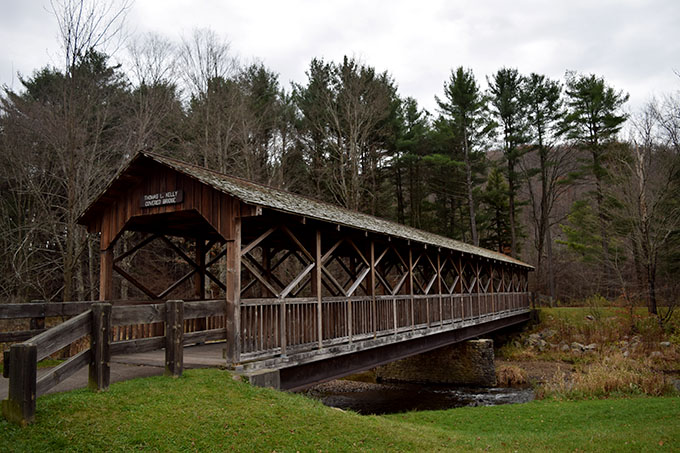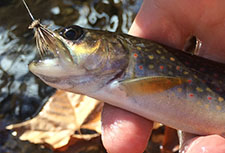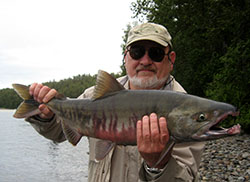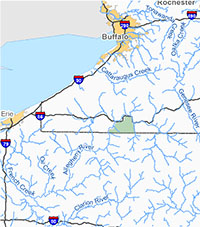As natural gas extraction expands across the Central Appalachian region, that industrial-scale energy development is encroaching on public lands that are critically important for fishing and hunting. In this report, Trout Unlimited takes a deeper look into those public places, outlining the potential risks posed by gas drilling operations and providing recommendations from sportsmen and women that promote responsible energy development.
Allegany State Park

The Place
The Allegany Park is New York’s largest state park. More than 80 percent of the park has been designated as a Park Preservation Area — a legal designation that limits intense development and allows only passive public recreation activities such as hiking, hunting and fishing.The park has the largest concentration of wild brook trout streams in western New York and features the largest contiguous area of publicly accessible wild and stocked trout fishing in the state. In the winter, ice fishing on Quaker and Red House lakes provide ambitious anglers with winter recreational opportunities. On the southern border, the Allegany State Park connects to Pennsylvania’s Allegheny National Forest, forming a continuous path for wildlife to move across the landscape. Hunters can find trophy deer and plentiful small game, such as ruffed grouse, turkey, woodcock and pheasant.
The Threat
In 2009, New York state banned the development, extraction or leasing of any state-owned oil and gas resources within the Allegany State Park. However, approximately 40 percent of the mineral rights beneath the park have been owned by private interests for generations and these rights are scattered throughout the park.Where it can, New York is acquiring privately-owned mineral rights. A 2011 law declared that any of the 40 percent of privately-held mineral rights within the Allegany State Park that have not actively been used within the past 20 years will revert to the state, if not claimed before Sept. 22, 2013. Where private subsurface mineral rights are reserved, strict oversight is required by the state park agency for any effort to drill within the Allegany State Park.
While New York has recently taken steps to protect the valuable habitat in the Allegany State Park, the threat of litigation over unclaimed private mineral rights under the 2011 law looms, creating uncertainty about how future development of privately-held or contested mineral rights will impact the park’s fish and wildlife. Potential adverse impacts of shale drilling on the park’s forests, streams, lakes and hillsides include clearing of trees and vegetation, construction of roads, installation of wells and pipelines, use and pollution of water, introduction and spread of invasive species and fragmentation and degradation of fish and game habitat.
The Need to Protect
 Sportsmen and women have a significant interest in protecting the unique resources of the Allegany State Park and will continue to work in partnership with New York officials to ensure that any drilling-related activities related to privately-held mineral rights, if permitted on park lands, occur in a responsible manner. Adoption of protective measures is imperative to safeguard the park’s valuable resources, including restricting the placement of well pads, access roads and pipelines in the park, limiting surface disturbance from drilling-related construction and activities and requiring re-vegetation of cleared areas with native plants as soon as possible after construction activities are complete. To preserve the quality of the sporting experience, at a minimum, drilling activities should be prohibited on popular opening days of fishing and hunting seasons.
Sportsmen and women have a significant interest in protecting the unique resources of the Allegany State Park and will continue to work in partnership with New York officials to ensure that any drilling-related activities related to privately-held mineral rights, if permitted on park lands, occur in a responsible manner. Adoption of protective measures is imperative to safeguard the park’s valuable resources, including restricting the placement of well pads, access roads and pipelines in the park, limiting surface disturbance from drilling-related construction and activities and requiring re-vegetation of cleared areas with native plants as soon as possible after construction activities are complete. To preserve the quality of the sporting experience, at a minimum, drilling activities should be prohibited on popular opening days of fishing and hunting seasons.
SPORTSMEN IN THE SPOTLIGHT
We need to make sure if natural gas is being produced, the environment is protected to the highest level.”Stan Bishop, Red House Brook Chapter of TU



